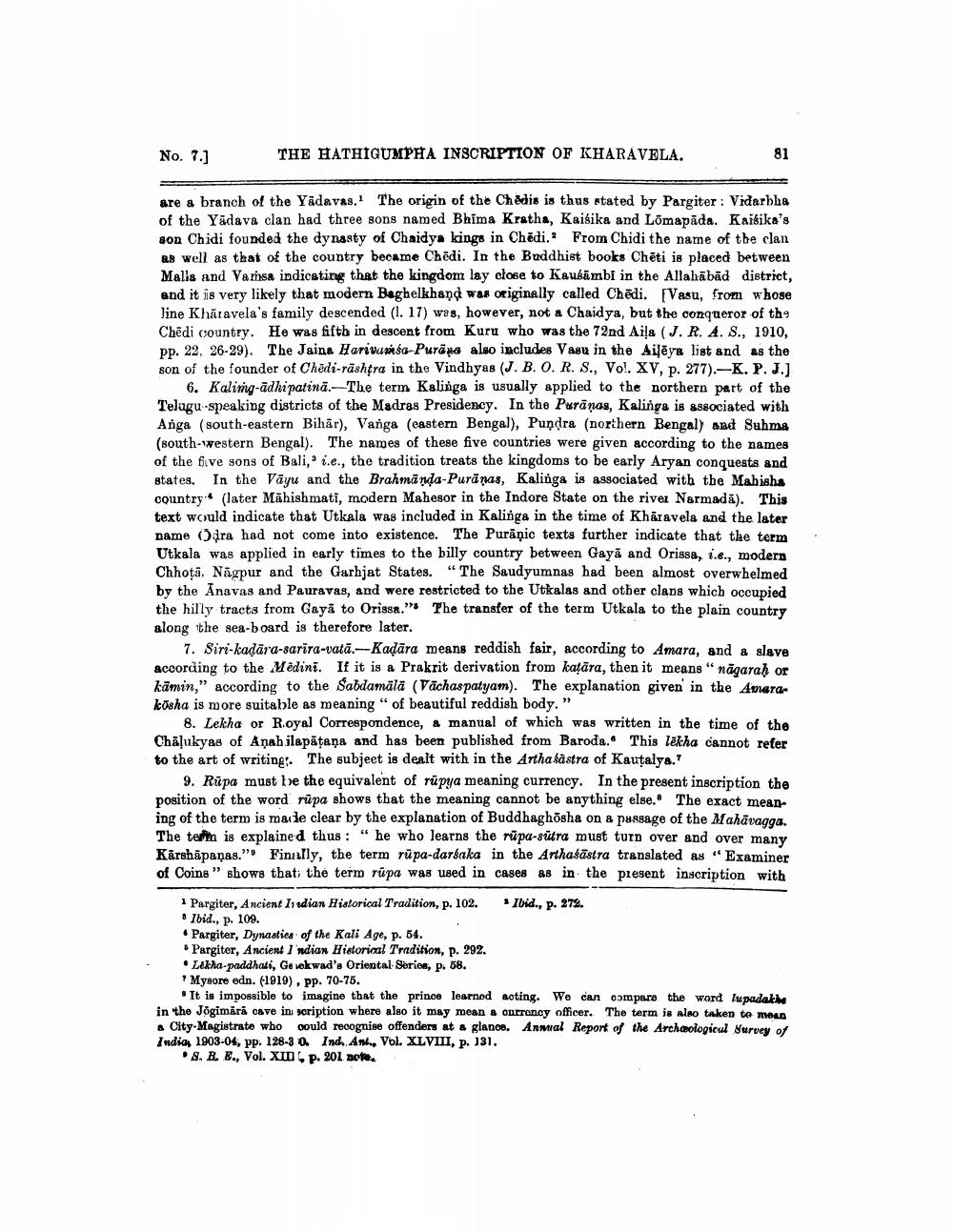________________
No. 7.]
THE HATHIGUMPHA INSCRIPTION OF KHARAVELA.
81
are a branch of the Yādavas. The origin of the Chedis is thus stated by Pargiter : Vidarbha of the Yadava clan had three sons named Bhima Kratha, Kaišika and Lomapada. Kaifika's son Chidi founded the dynasty of Chaidya kings in Chēdi. From Chidi the name of the clan as well as that of the country became Chēdi. In the Buddhist books Chēti is placed between Malla and Varsa indicating that the kingdom lay close to Kausāmbi in the Allahābād district, and it is very likely that modern Baghelkhand was originally called Chēdi. Vasu, from whose Jine Kharavela's family descended (1. 17) was, however, not a Chaidya, but the conqueror of the Chēdi country. He was fifth in descent from Kuru who was the 72nd Aila (J. R. A. S., 1910, pp. 22, 26-29). The Jaina Harivansa-Purana also includes Vasu in the Aiļēya list and as the son of the founder of Chëdi-rashtra in the Vindhyas (J. B.O.R.S., Vol. XV, p. 277).-K. P. J.)
6. Kaling-ādhi patinā.-The term Kalinga is usually applied to the northern part of the Telagu-speaking districts of the Madras Presidency. In the Purānas, Kalinga is associated with Anga (south-eastern Bihár), Vanga (eastern Bengal), Pundra (northern Bengal) and Suhma (south-western Bengal). The names of these five countries were given according to the names of the five sons of Bali,' i.e., the tradition treats the kingdoms to be early Aryan conquests and states. In the Vāyu and the Brahmānda-Purānas, Kalinga is associated with the Mahisha country (later Māhishmati, modern Mahesor in the Indore State on the river Narmadā). This text would indicate that Utkala was included in Kalinga in the time of Kharavela and the later name Odra had not come into existence. The Purāņic texts further indicate that the term Utkala was applied in early times to the billy country between Gaya and Orissa, i.e., modern Chhota. Nagpur and the Garhjat States. “The Saudyumnas had been almost overwhelmed by the Anavas and Pauravas, and were restricted to the Utkalas and other clans which occupied the hilly tracts from Gaya to Orissa." The transfer of the term Utkala to the plain country along the sea-board is therefore later.
7. Siri-kadara-sarira-vatā.Kadāra means reddish fair, according to Amara, and a slave according to the Mëdini. If it is a Prakrit derivation from katāra, then it means" nāgarah or kāmin,” according to the Sabdamála (Vāchaspatyam). The explanation given in the Amarakösha is more suitable as meaning " of beautiful reddish body."
8. Lekha or Royal Correspondence, & manual of which was written in the time of the Chāļukyas of Anahilapātana and has been published from Baroda. This lekha cannot refer to the art of writing. The subjeet is dealt with in the Artha kastra of Kautalya.?
9. Rūpa must be the equivalent of rupya meaning currency. In the present inscription the position of the word rūpa shows that the meaning cannot be anything else. The exact mean ing of the term is made clear by the explanation of Buddhaghosha on a passage of the Mahāvagga. The term is explained thus : "he who learns the rupa-sutra must turn over and over many Kärshāpanas." Finally, the term rupa-darsaka in the Arthaśāstra translated as "Examiner of Coins” shows that the term rūpa was used in cases 88 in the present inscription with
1 Pargiter, Ancient Indian Historical Tradition, p. 102. Ibid., p. 272. • Ibid., p. 109. • Pargiter, Dynasties of the Kali Age, p. 54.
Pargiter, Ancient Indian Historical Tradition, p. 292. • Lekha-paddhati, Ge ekwad's Oriental Serion, p. 58. ? Mysore edn. (1919), pp. 70-75.
It is impossible to imagine that the prince learned acting. We can compare the word lupadakhe in the Jögimärä сave in scription where also it may mean a currency officer. The term is also taken te moen & City-Magistrate who could recognise offenders at a glance. Anmal Report of the Archaologioul Survey of India 1903-04, pp. 128-30. Ind. Ant., Vol. XLVIII, p. 131.
.S.B.E., Vol. XID(p. 201. Doma




